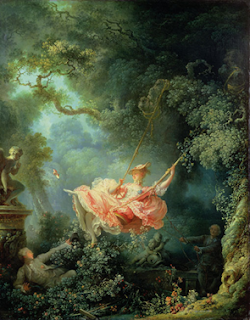Adam and Eve by Albrecht Durer
Albrecht Durer created Adam and Eve
in 1504. This was the only artwork that Durer signed his whole name too. Albrecht
Durer was determined that there was the ideal form to have and to draw, and
that there was a way to learn how to draw those images. The ideal form for Durer
started with Adam and Eve where they were the first couple to have nearly
symmetrical idealized poses. Durer “described
using a ruler and compass during the construction of the Adam and Eve figures
in order to get the metrics completely correct in line with the theory of
perfect human geometry that he was developing.” (Adam and Eve Engraving). Humanism
was used in creating the art. The poses of Adam and Eve are very similar. They both
have one arm bent and held up while the other arm is down, and they both have
weight on one leg while the other leg is sort of off to the side. “The figure
of Adam is reminiscent of the Hellenistic Apollo Belvedere, excavated in Italy
late in the fifteenth century.” (Adam and Eve, Wisse). Using Humanism, Wisse focused
on how Adam and Eve were standing, how unique they can be while following the
same poses, and how their faces and ways they are can tell a story. They were
both focused on their worth and dignity, but also how they can relate to each
other. Adam and Eve is related to religion also, being believed as they were
the first two people to ever walk the Earth.
There
is symbolism in the picture as well. If you look at the picture you will find
the following animals: parrot, snake, and Elk. According to the research that I
have found, the tree between Adam and Eve, is supposed to be the trunk of a fig
tree. This fig tree is supposed to represent the Tree of Knowledge. The snake
is wrapped around the tree and if you look closely, you can see an apple in the
Snakes mouth that Eve is holding in her hand.
The
background is not of Earth, but it is a dark Germanic Forest. Adam and Eve, in
the painting above, was inspired to Durer by some of the classical Greek
statues. Two of those statues were the Apollo Belvedere and the Venus de’
Medici.
Growing
up, I went to church and was always told the story of Adam and Eve, and how
they were the first two people to ever walk the Earth. I was taught about how Eve
betrayed Adam with the snake. Seeing in this artwork and learning about all the
qualities of art really puts it into perspective for me. The perspective of the
grey and white photo at first is astonishing. They use a darker shade of grey,
almost black to show the forest, and then they use other shades of a lighter
grey in the front to show Adam and Eve standing in front of a tree. The tree is
designed to seem as though it is standing behind them. You can also see the texture
in the leaves and even the texture in their stomach muscles to make out muscles
they have and earned. There is even a bird in the top left corner that, because
the lines and texture are so detailed, you can see and make up the different
parts of the bird. After creating this painting, Durer went and traveled around
Germany, Switzerland, and Italy, to continue feeding his thirst for knowledge
and learning.
At
first, before starting this class, I probably would have said I would not want
to own a copy of this artwork. However, being in this class has already opened
my eyes to all the varying types of art and all the attributes and qualities it
has. I would not mind owning something like this painting. I can relate to learning
the history as a child of Adam and would love to learn all about the history of
this exact painting, and just being able to study the painting.
References:
"Adam and Eve (engraving)." Albert Durer, 2021,
www.albrechtdurer.org/adam-and-eve-engraving/.
Wisse, Jacob. "Adam and Eve." The MET, edited by
Jacob Wisse, Nov. 2002, www.metmuseum.org/art/collection/search/336222.




Thank you for bringing my attention to this piece.
ReplyDeleteIs there any more quintessentially Humanist subject matter than Adam and Eve? I love that Durer was seeking to portray the ideal human form and emphasized their symmetry. The composition is balanced overall in a way that compliments their symmetry. In spite of the sharp monochromatic contrasts of the woodcut, the human forms appear soft and yielding.
This class has also opened my eyes to the qualities of art pieces I would normally not find appealing! I really enjoyed the extensive research and background you were able to find on this piece. I specifically found it fascinating that Durer used a ruler and compass to achieve perfect geometry. I would have never guessed that by simply looking at the painting.
ReplyDelete